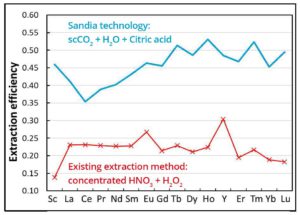Food-grade solvent can be used to extract rare earth metals from coal ash
In a controlled setting, the group found that in less than a day, at 70 degrees Celsius and 1,100 pounds per square inch pressure (about 70 times ordinary atmospheric pressure), the method extracted 42% of rare-earth metals present in coal waste samples.
“This technique not only recovers rare-earth metals in an environmentally harmless manner but would actually improve environments by reducing the toxicity of coal waste dotting America,” Guangping Xu, lead Sandia researcher on the project, said.

Guangping pointed out that the most common acids used as chemical separators in mining — nitric, sulfuric or phosphoric acids — also are able to extract rare-earth metals from coal ash but produce large amounts of acid waste, thus causing severe environmental damage.
“Harmless extraction of rare-earth metals from coal ash not only provides a national source of materials essential for computer chips, smartphones and other high-tech products — including fighter jets and submarines — but also make the coal ash cleaner and less toxic, enabling its direct reuse as concrete filler or agricultural topsoil.”
In Guangping’s view, the method, if widely adopted, could turn coal ash from an environmental pariah into a commercially viable product.
Citing a 2016 paper published in the journal Environmental Science and Technology, the geologist and Ph.D. in geochemistry said that, in the United States, approximately 115 million metric tons of coal combustion products are generated annually, and this sum includes 45 million tons of fly ash. This means that if companies decide to go ahead with Sandia’s patent-pending process, they would not lack the necessary raw input.
“Theoretically, an American company could use this technique to mine coal and coal byproducts for rare-earth metals and compete with Chinese mining,” Guangping said.
Data released by Foreign Policy show that China produces or controls over 70% of the world’s mined rare earths, it refines more than 80% of all rare earths into mixed oxides and separates more than 90% of all rare earths into individual elements.
For Guangping, given this state of affairs, “it is probably reasonable to have alternate sources of rare-earth metals to avoid being at the mercy of a foreign supply.”




